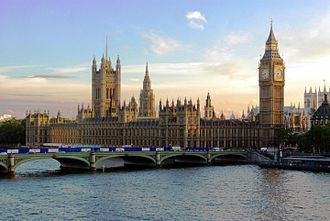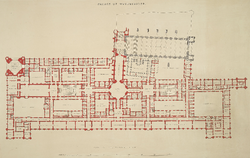Palace of Westminster
The Palace of Westminster, also known as the Houses of Parliament or Westminster Palace, in London, is where the two Houses of the Parliament of the United Kingdom meet.
| Palace of Westminster | |
|---|---|
 The Palace of Westminster with Elizabeth Tower and Westminster Bridge, viewed from across the River Thames | |
| Location | City of Westminster, London, England |
| Area | 112,476 m2 (1,210,680 sq ft) [1] (internal) |
| Built | 1016 |
| Demolished | 1834 (due to fire) |
| Rebuilt | 1840–70 |
| Architectural style(s) | Perpendicular Gothic Revival |
| Official name: Palace of Westminster, Westminster Abbey, and St Margaret's Church | |
| Type | Cultural |
| Criteria | i, ii, iv |
| Designated | 1987 (11th session) |
| Reference No. | 426 |
| Country | United Kingdom |
| Region | Europe |
| Extensions | 2008 |
Listed Building – Grade I | |
| Official name: Houses of Parliament / The Palace of Westminster | |
| Designated | 5 February 1970 |
| Reference No. | 1226284[2] |

In 1605, Guy Fawkes attempted to blow the Palace up. He was caught and later executed. This was called the Gunpowder Plot, and is celebrated on 5 November every year.
The original building was used as a palace and home to the Parliament of England. After a fire in 1834, the building was used as a Parliament building.
Westminster Palace, Westminster Abbey and Saint Margaret's Church make up a UNESCO World Heritage Site.[3] Westminster Palace is an example of Gothic Revival architecture.[3]
The building is in bad shape. There have been falling stonework, 10 fires, and an incident of potential asbestos exposure since 2020. There are leaking pipes and a serious risk of fire. The water, electric, sewage and gas pipes need to be replaced. To do this work the politicians would have to move to somewhere else.[4]
Palace Of Westminster Media
Conjectural restoration of Westminster during the reign of Henry VIII (1509–1547). St Stephen's Chapel is in the centre, with the White Chamber and Painted Chamber on the left and Westminster Hall on the right.
J. M. W. Turner watched the fire of 1834 and painted several canvases depicting it, including The Burning of the Houses of Lords and Commons (1835).
The old chamber of the House of Commons was in use between 1852 and 1941, when it was destroyed by German bombs in the course of the Second World War.
Cromwell Green, outside Westminster Hall, is the site of Hamo Thornycroft's bronze statue of Oliver Cromwell, erected amid controversy in 1899.
References
- ↑ "Palace of Westminster: Factsheet" (PDF). Restoration and Renewal. Houses of Parliament. Archived from the original (PDF) on 14 September 2017. Retrieved 13 September 2017.
- ↑ Historic England. "Details from listed building database (1226284)". National Heritage List for England (NHLE). Retrieved 9 July 2015.
- ↑ 3.0 3.1 UNESCO, "Westminster Palace, Westminster Abbey and Saint Margaret's Church"; retrieved 2012-4-21.
- ↑ Fisher, Lucy (2023-07-31). "MPs are stuck as UK parliament crumbles around them". Financial Times. https://www.ft.com/content/4b450ac8-6211-4063-8cb4-bfc98cbe8d69. Retrieved 2023-07-31.
Other websites
![]() Media related to Palace of Westminster at Wikimedia Commons
Media related to Palace of Westminster at Wikimedia Commons
- Parliament.uk, Palace of Westminster
- Westminster Abbey website
- St Margaret's Church Archived 2013-09-26 at the Wayback Machine
![]()








